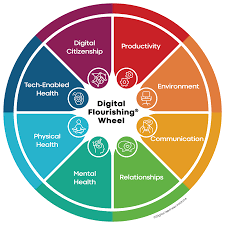Explore the intersection of wellness and technology in the digital era. Learn how tech innovations shape our health and practical tips for balanced digital living.
In today’s fast-paced digital world, technology influences nearly every aspect of our lives, including our health and well-being. From wearable health devices to mental health apps, the digital age has brought immense opportunities for improving wellness. However, it also presents challenges, such as digital burnout and privacy concerns. This article delves into the ways technology shapes our health, offering insights and actionable strategies for navigating wellness in the digital era.
The Benefits of Technology for Wellness
1. Improved Access to Healthcare
Digital innovations like telemedicine and online health portals have made healthcare more accessible than ever. Patients can now schedule virtual consultations, access medical records, and even receive prescriptions online. These advancements are particularly impactful for those in remote or underserved areas.
2. Personalized Health Monitoring
Wearables such as fitness trackers and smartwatches empower individuals to monitor their health in real-time. These devices track steps, heart rate, sleep patterns, and more, providing personalized insights that encourage healthier lifestyles.
3. Mental Health Support
Mental health apps and online platforms have democratized access to mental health resources. From meditation apps to virtual therapy sessions, technology is breaking down barriers and making mental health support more accessible and less stigmatized.
4. Enhanced Health Education
The internet offers a wealth of information on health and wellness. Blogs, videos, and apps provide easy access to reliable health tips, fitness routines, and nutrition advice, enabling individuals to make informed decisions about their well-being.
The Challenges of Technology for Wellness
1. Physical Health Risks
a. Sedentary Lifestyles: Prolonged screen time and reliance on digital tools can lead to sedentary behaviors, increasing risks for obesity, cardiovascular diseases, and musculoskeletal issues. b. Eye Strain and Sleep Disruption: Excessive screen use can cause digital eye strain and disrupt sleep cycles due to blue light exposure.
2. Mental Health Concerns
a. Social Media Anxiety: Overuse of social media can contribute to feelings of inadequacy, loneliness, and anxiety. b. Digital Overload: Constant notifications and the “always-on” culture can lead to stress, burnout, and difficulty focusing.
3. Privacy and Security Issues
The integration of technology in health raises concerns about data privacy and security. Many health apps collect sensitive data, making it essential to choose platforms with robust security measures.
Strategies for Balanced Digital Wellness
1. Set Digital Boundaries
Establish clear boundaries for technology use, such as screen-free times during meals or before bedtime. This helps maintain a healthy work-life balance and reduces screen fatigue.
2. Incorporate Movement into Your Routine
Combat sedentary habits by incorporating physical activity into your day. Use fitness apps or smartwatches to set reminders for stretching, walking, or exercising.
3. Practice Mindful Technology Use
Adopt mindful habits, such as turning off unnecessary notifications and using apps designed to improve focus and mental clarity. Mindfulness apps can also help manage stress and anxiety.
4. Choose Trusted Health Platforms
When using health apps, prioritize platforms with strong privacy policies and security features. Regularly review app permissions and avoid sharing unnecessary personal data.
5. Engage in Regular Digital Detoxes
Take periodic breaks from technology to recharge. Whether it’s a weekend without screens or daily unplugged hours, digital detoxes can improve mental clarity and reduce stress.
The Role of Policymakers and Organizations
Governments, businesses, and healthcare providers play a crucial role in shaping digital wellness. Policies that promote ethical data use, provide digital literacy education, and regulate screen time for children can support healthier digital habits. Employers can also foster a culture of balance by encouraging breaks and offering wellness programs.
Conclusion
Navigating wellness in the digital era requires a mindful approach to technology use. While digital tools offer tremendous benefits for health and well-being, they also come with challenges that require careful management. By adopting strategies for balanced digital living and advocating for responsible tech use, individuals and society can harness the potential of technology to enhance overall wellness.
FAQ
Q: How does technology improve access to healthcare? A: Telemedicine and online platforms enable patients to consult doctors, access medical records, and receive prescriptions remotely, improving healthcare accessibility.
Q: What are some tips for reducing screen-related eye strain? A: Follow the 20-20-20 rule: every 20 minutes, look at something 20 feet away for 20 seconds. Use blue light filters and maintain proper screen brightness.
Q: Can technology help with mental health? A: Yes, apps and online platforms offer meditation guides, virtual therapy sessions, and crisis support, making mental health resources more accessible.
Q: What is a digital detox? A: A digital detox involves taking a break from screens and technology to recharge and improve mental clarity. It can include screen-free hours or days.
Q: How can I ensure my health data is secure? A: Use trusted apps with strong privacy policies, review app permissions, and avoid sharing unnecessary personal information.